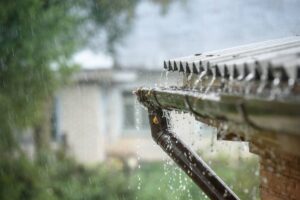3 Drainage Options for Your Roof
 A properly functioning drainage system can help protect your home against water damage. Without a functional drainage system, you run the risk of mold, mildew, and rot due to water pooling on your roof. However, are you aware of the common drainage options you can get for your property? Here are three of the most common drainage options for your roof and the pros and cons of each.
A properly functioning drainage system can help protect your home against water damage. Without a functional drainage system, you run the risk of mold, mildew, and rot due to water pooling on your roof. However, are you aware of the common drainage options you can get for your property? Here are three of the most common drainage options for your roof and the pros and cons of each.
1. Gutters
Gutters are the most popular external drainage system with pitched roofs because they rely on the roof’s angular inclination to drain water. Your roof technician will normally install gutters along the margins of a roof. Gutter manufacturers design them to collect and carry water running off the roof into downspouts.Downspouts are pipes that attach to the gutters and direct water away from the structure, most often to a storm drain. The downspouts attach to gutters and carry water away from the building. They consist of metal or plastic and are available in various sizes and shapes. The most typical downspout forms are round or rectangular, but styles that are more ornate are available.
Gutters frequently consist of metals like aluminum or plastics like polyvinyl chloride (PVC). They also come in a range of shapes and sizes to accommodate the needs of the building. The U-shaped gutter is a common style that captures the most water and sends it into the downspouts.
Gutters are simple to set up and maintain, but they may require replacement if damaged. Gutters are also prone to clogs from dirt, leaves, and other objects, which results in spills and flooding. They need regular maintenance to avoid obstructions.
2. Internal Drains
Internal drains are drainage networks constructed underneath the surface of a flat roof instead of on the outside of it. They draw water from the roof into a downspout through deliberately positioned drainage holes. This design enables a functional drainage system without detracting from the structure’s appearance with exposed pipework.One of the benefits of this system is that your roof technician can conceal them from view, which means it will not distract from the structure’s beauty and will not provide a tripping hazard. Internal drains can also withstand colder conditions better.
However, this type of drainage demands more upkeep than other systems because the drains are harder to access. You should examine them for obstructions more frequently.
Furthermore, if the downspout were to break, the leaking water would most likely make its way into the building, whereas a gutter would simply pour down the building’s exterior. As a result, ensure that the internal drain system receives routine and proper maintenance.
3. Scuppers
Scuppers are a good drainage alternative for flat roofs with an enclosing wall or a little lip to keep the water in. They are open-hole conduits constructed along the outermost portion of a roof and slope downward to guide the water flow.The downward angle and force of the water help to keep the walls and siding free of moisture and prevent the building’s base from excessive exposure to water.
Scuppers can function with a tapered insulation structure or a sloped framework to guarantee water goes in the necessary direction. They are far less expensive than alternative drainage methods and allow the roof and exterior of the building to stay clutter-free.
One of the downsides of this system is that it may become clogged and is difficult to set up. They are also inefficient at managing melted snow and ice, which makes them a less-than-ideal alternative in locations with heavy snowfall.
Contact us at Ray’s Harford Home Improvement Contractors, Inc., for roof upgrades, installations, repairs, and maintenance. We serve many regions located within Maryland.

